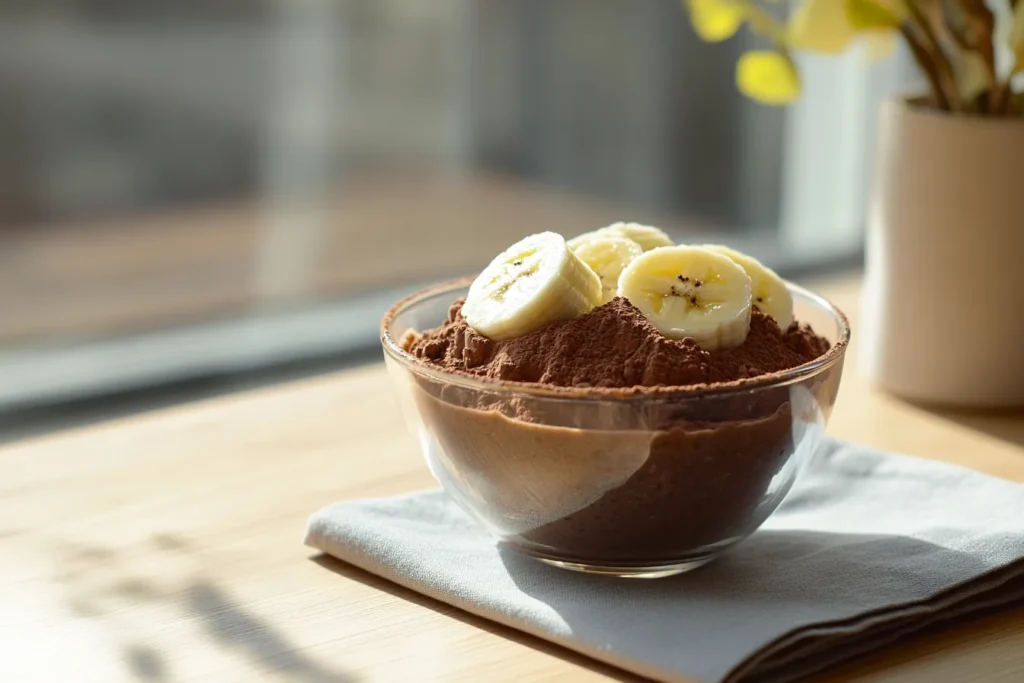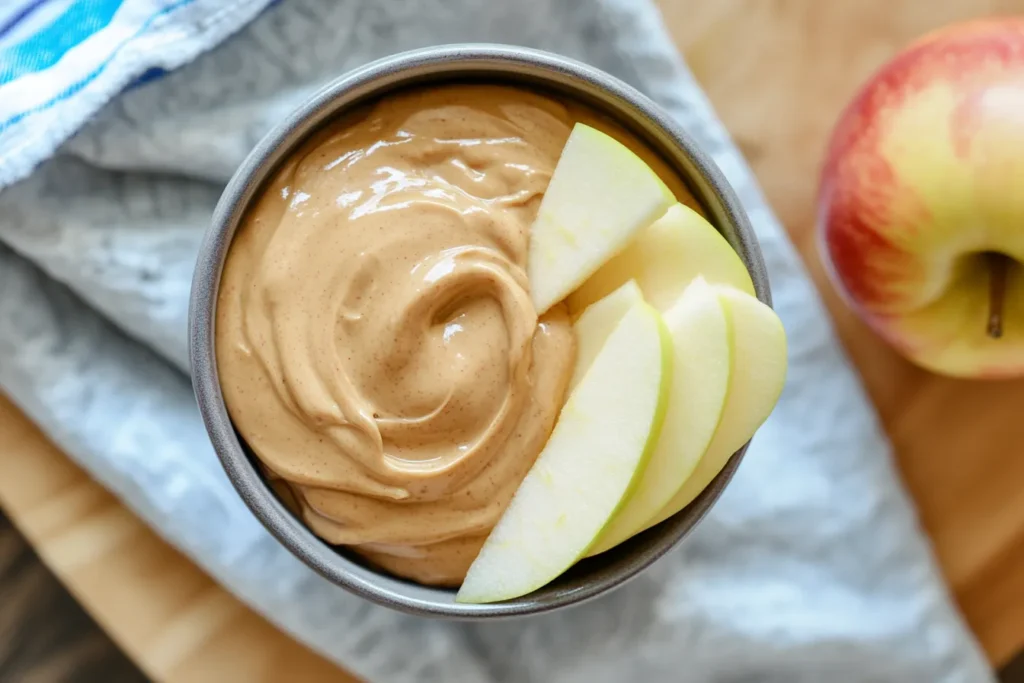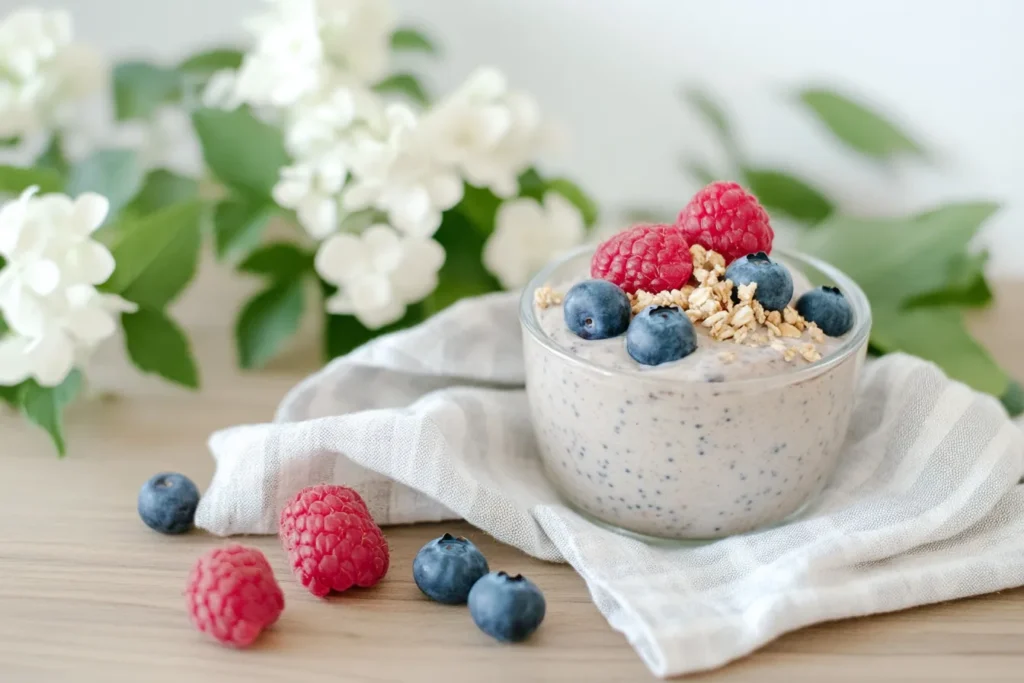Understanding Protein Pudding and Its Role in Muscle Gain
Protein pudding isn’t your everyday dessert—oh no, it’s a fitness-friendly snack that packs a punch! Essentially, it’s a creamy, protein-rich treat designed to satisfy your cravings and fuel your muscle recovery. Unlike traditional pudding loaded with sugars and empty calories, protein pudding is fortified with high-quality protein sources like whey, casein, or plant-based proteins.
But here’s the kicker: not all protein puddings are created equal. Some have stellar ingredients, while others sneak in artificial fillers that do more harm than good. This section sets the stage for understanding why it’s essential to choose the right kind and what makes it such a popular choice for muscle gain.
The Benefits of Protein Pudding for Muscle Development
Muscle-building requires the right balance of macronutrients, and protein pudding fits the bill perfectly. The high protein content helps repair muscle fibers after intense workouts and boosts protein synthesis, a fancy term for muscle growth. Plus, protein pudding is usually lower in carbs than traditional snacks, making it an ideal post-workout treat or a between-meals option.
Additionally, there’s a convenience factor. Unlike shakes that require mixing or bars that can be chewy, protein pudding is ready-to-eat and spoonable. Whether you’re on the go or relaxing at home, it’s an easy way to sneak in those extra grams of protein.
Nutritional Profile of Protein Pudding
Nutritional Breakdown of Protein Pudding (Per 100g Serving)
| Nutrient | Amount per 100g |
|---|---|
| Calories | 120 kcal |
| Protein | 15-25g |
| Carbohydrates | 6-10g |
| Sugars | 3-6g |
| Fat | 2-5g |
| Saturated Fat | 1-2g |
| Fiber | 1-2g |
| Sodium | 150-200mg |
Understanding the nutritional breakdown of protein pudding is essential when deciding if it’s right for your muscle gain goals. Unlike conventional desserts, protein pudding boasts a balanced mix of macronutrients and micronutrients, providing both fuel for recovery and support for overall health. Let’s explore what’s really inside that creamy goodness!
Macronutrient Composition
Protein pudding’s macronutrient content is what sets it apart from typical puddings. It’s specifically formulated to provide higher protein levels while keeping fats and sugars in check.
Protein Content
Protein is the star of the show, and rightly so! Most protein puddings contain between 15 to 25 grams of protein per serving, depending on the brand and type. Common protein sources include whey, casein, and sometimes pea or soy protein for plant-based options.
Why does this matter? Whey protein digests quickly, making it perfect for post-workout recovery, while casein digests slowly, providing a sustained release of amino acids to repair muscles over time. Whichever you choose, it’s a win for your muscle fibers.

Carbohydrates and Sugars
Carbohydrate content varies, but most protein puddings aim to keep sugar levels low—often containing less than 10 grams of sugar per serving. Instead, brands may use sugar alternatives like stevia, monk fruit, or erythritol to maintain sweetness without the glycemic spike.
That said, not all carbs are bad! Some protein puddings contain a small amount of complex carbs for an added energy boost, which can be beneficial before an intense workout.
Fats and Caloric Value
Protein puddings typically have 2 to 5 grams of fat per serving. The type of fat matters—those made with healthy fats like coconut milk or almond milk provide some additional benefits, while those with hydrogenated oils should be avoided.
When it comes to calories, most servings range between 100 to 200 calories, making it easy to fit into your daily caloric intake without overindulging.
Micronutrient Benefits
While protein and calories grab the spotlight, the micronutrients in protein pudding can also play a key role in muscle recovery and overall well-being.
Vitamins and Minerals
Some protein puddings are fortified with vitamins like vitamin D, calcium, and magnesium, which are vital for muscle contractions, bone health, and immune support. Calcium, in particular, is often abundant in dairy-based protein puddings and contributes to stronger bones—a bonus for anyone lifting heavy weights.
Presence of Additives and Preservatives
However, not everything is rosy!Many commercial protein puddings contain thickeners like xanthan gum or guar gum and preservatives to extend shelf life, raising questions about whether are protein puddings healthy. While these additives are generally safe in small amounts, excessive consumption can cause digestive discomfort.
That’s why It’s crucial to read the label and opt for brands that prioritize simple, high-quality ingredients—and also to know how long protein pudding lasts in the fridge to avoid waste. You can even make homemade versions to have full control over what goes in!
Protein Pudding in Muscle Gain
To truly appreciate the role of protein pudding in muscle gain, it’s important to understand why protein itself is essential and how this tasty snack stacks up against other popular sources of protein. Timing and consumption also play a significant role in maximizing its benefits—after all, when you eat can be just as important as what you eat!
Importance of Protein in Muscle Development
Protein is the building block of muscles. When you perform resistance exercises, tiny tears form in your muscle fibers. Protein provides the amino acids needed to repair and rebuild those fibers, making them stronger and larger.
But here’s the thing: not all proteins are created equal. Complete proteins—like those found in dairy-based protein puddings—contain all nine essential amino acids, which are critical for muscle repair and growth. Protein pudding can therefore serve as a convenient and effective way to meet your daily protein needs, especially for those who have a sweet tooth but don’t want to compromise on their fitness goals.
Comparing Protein Pudding to Other Protein Sources
To see how protein pudding fits into your diet, let’s compare it to other common protein sources.
Whey Protein Shakes
Whey protein shakes are a staple in the fitness world—and for good reason! They’re quick, easy, and highly effective. However, they can sometimes be a bit bland or chalky, especially if not mixed properly.
Compared to protein pudding, shakes typically contain more protein per serving (20 to 30 grams) but lack the creamy texture and dessert-like appeal. Additionally, protein pudding can be more filling due to its thicker consistency, making it a great choice for those who struggle with hunger between meals.
Protein Bars
Protein bars are another go-to option for on-the-go fitness enthusiasts. They often pack 15 to 20 grams of protein and come in a variety of flavors. However, some bars are loaded with added sugars, artificial flavors, and preservatives, which can negate their health benefits.
Unlike protein pudding, which is usually eaten with a spoon and digested a bit slower, protein bars can spike blood sugar levels, leading to a quicker energy crash. Protein pudding, especially when made with casein protein, offers a sustained release of amino acids, making it more suitable as a long-lasting muscle-building option.
Whole Food Sources
Whole foods like chicken breast, fish, eggs, and legumes are some of the best sources of protein. They’re nutrient-dense and often provide additional vitamins and minerals. But here’s the catch—preparing whole foods takes time, and it’s not always convenient to carry a hard-boiled egg or grilled chicken breast around!
Protein pudding, on the other hand, is ready to eat and mess-free. Plus, it can be stored easily in small containers, making it perfect for those with a busy schedule who still want a protein-packed option.
Timing and Consumption of Protein Pudding for Optimal Muscle Gain
When you eat protein pudding can significantly affect its benefits. Let’s explore the best times to enjoy this tasty treat for optimal results.
Pre-Workout

Eating protein pudding 30 to 60 minutes before a workout can provide a slow, steady release of amino acids that fuel your muscles throughout your training session. If you choose a pudding made with casein or a blend of slow and fast-digesting proteins, you’ll have enough energy to power through without feeling bloated.
For an extra boost, try adding a small portion of oats or a banana on top for some healthy carbs to increase your stamina.
Post-Workout

Post-workout is when your muscles crave nutrients the most. Consuming protein pudding immediately after exercise—preferably within 30 minutes—helps kickstart muscle recovery and protein synthesis. Whey-based puddings are a particularly good choice here because of their quick absorption rate.
You can even mix in some berries or dark chocolate shavings for added antioxidants that help combat inflammation.
As a Meal Replacement or Snack
If you’re looking for a convenient, high-protein snack between meals, protein pudding is your best bet. Thanks to its high protein content and satisfying texture, it can keep hunger at bay and prevent unnecessary snacking on junk foods.
For meal replacements, choose versions with higher calories and healthy fats—think almond butter or chia seeds—to make it more filling and nutrient-dense. This makes protein pudding not only delicious but also practical for those days when you’re short on time but still want to meet your macros!
Considerations When Incorporating Protein Pudding into Your Diet
Before you dive spoon-first into a cup of protein pudding, it’s worth considering the pros and cons. While it can be a fantastic addition to your fitness routine, certain factors—like ingredients and cost—can influence how beneficial it really is for you. Let’s break down what you need to know.
Potential Benefits
Protein pudding isn’t just another trendy health food; it comes with real advantages for both fitness enthusiasts and everyday snackers.
Convenience and Taste
One of the biggest perks of protein pudding is how easy it is to enjoy. No blending, no prep—just grab a spoon, and you’re good to go! Compared to shakes that require mixing and protein bars that can feel dense or overly chewy, protein pudding’s creamy texture makes it feel like a real treat.
Plus, it comes in a wide variety of flavors, from rich chocolate to fruity blends, so you’re less likely to get bored with your snack choices.
Satiety and Weight Management
Thanks to its high protein content, protein pudding can help keep you fuller for longer, making it an excellent option for curbing midday hunger. Unlike sugary snacks that cause a rapid spike (and then crash) in blood sugar, protein pudding delivers a slow release of energy that stabilizes your appetite.
For anyone working toward muscle gain while trying to maintain or lose fat, this balance of protein and minimal sugars is key for staying on track.
Potential Drawbacks
No snack is perfect, and protein pudding does come with a few potential downsides to keep in mind.
Added Sugars and Artificial Ingredients
Some protein puddings, especially the more mass-produced ones, sneak in artificial sweeteners, thickeners, and preservatives to improve flavor and texture. While these additives aren’t necessarily harmful in small amounts, overconsumption can lead to digestive issues, such as bloating or discomfort.
To minimize this, opt for products labeled as “clean” or with minimal ingredients. Homemade protein pudding is also an excellent alternative if you want full control over what’s going in—here’s a protein pudding recipe to try at home!
Cost Considerations
Let’s face it: protein-rich snacks often come with a higher price tag. Compared to protein powders, which provide several servings per container, pre-packaged protein puddings can cost more per serving.
However, this doesn’t mean they’re out of reach. Budget-friendly brands and homemade recipes can help you cut costs while still enjoying the convenience and benefits of this protein-packed treat.
Selecting the Right Protein Pudding
When it comes to choosing the best protein pudding, a bit of label-reading goes a long way. Here’s what to look for when you’re comparing your options:
Ingredient Quality
The shorter the ingredient list, the better! Avoid products with a laundry list of hard-to-pronounce additives and look for recognizable, whole-food ingredients. Natural sweeteners like stevia or monk fruit are preferable over artificial ones, and real cocoa or vanilla adds richer flavor without extra fillers.
Protein Source (Whey, Casein, Plant-Based)
The type of protein used can make a big difference in how your body digests and absorbs the nutrients.
- Whey protein is quickly absorbed, making it ideal for post-workout recovery.
- Casein protein digests more slowly, providing sustained muscle support—perfect for a bedtime snack.
- Plant-based proteins like pea or soy are excellent options for those with dairy sensitivities or who follow vegan diets.
Choose a pudding that aligns with your dietary needs and fitness goals.
Brand Reputation and Reviews
Before trying a new brand, it’s helpful to check out reviews from other customers or fitness experts. Look for feedback on taste, texture, and whether the product actually lives up to its nutritional claims.
Also, don’t overlook smaller, health-focused brands that may have higher-quality products compared to bigger companies that prioritize mass production over quality.
FAQs About Protein Pudding for Muscle Gain
Let’s tackle the most common questions about protein pudding and its role in building muscle.
What is protein pudding, and how is it different from regular pudding?
Protein pudding is a high-protein alternative to traditional pudding, designed for fitness enthusiasts. Unlike regular pudding, which is often full of sugars and empty calories, it contains 15 to 25 grams of protein per serving and fewer sugars and fats, making it great for muscle repair and growth.
Can protein pudding replace protein shakes?
It depends on your needs. Shakes offer more protein per serving and are quick to prepare, but protein pudding’s creamy texture makes it more satisfying and filling. If you prefer a dessert-like snack, pudding is ideal. For a fast post-workout protein boost, shakes may be better.
Is protein pudding suitable for all dietary needs?
Not all protein puddings are the same. Dairy-based puddings may not suit those with lactose intolerance, but plant-based options made with pea or soy protein are great for vegans or those with allergies.
How often should I eat protein pudding for muscle gain?
This depends on your goals, but generally, aim for 20 to 40 grams of protein per meal. Protein pudding can be a great post-workout snack, midday boost, or bedtime treat—especially casein-based versions. However, balance it with whole food sources of protein.
Conclusion
So, is protein pudding good for muscle gain? The answer is a resounding yes—when used strategically! Protein pudding offers a delicious, convenient way to increase your daily protein intake, support muscle recovery, and curb cravings. Whether you enjoy it as a post-workout treat, a pre-bedtime snack, or a midday pick-me-up, this versatile option can fit seamlessly into your fitness routine.
Just remember: balance is key. Pair protein pudding with a diet rich in whole foods, exercise consistently, and choose options with clean, high-quality ingredients. That way, you can enjoy the best of both worlds—a tasty snack and muscle gains to match!

